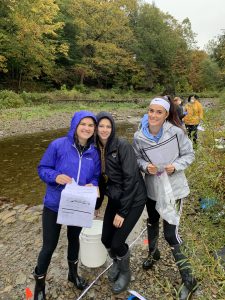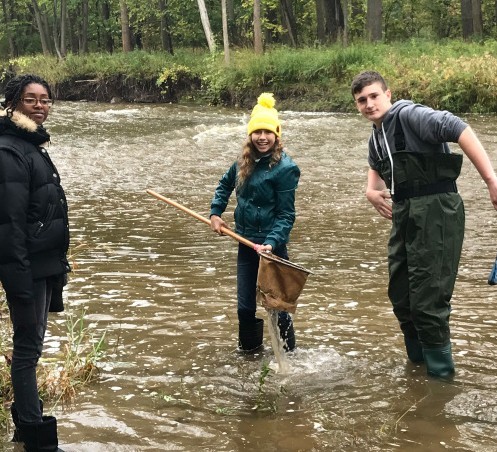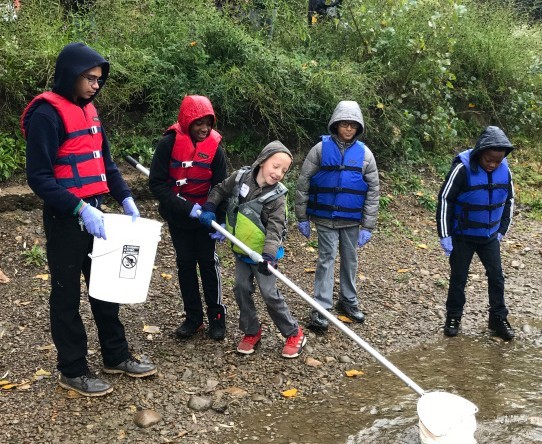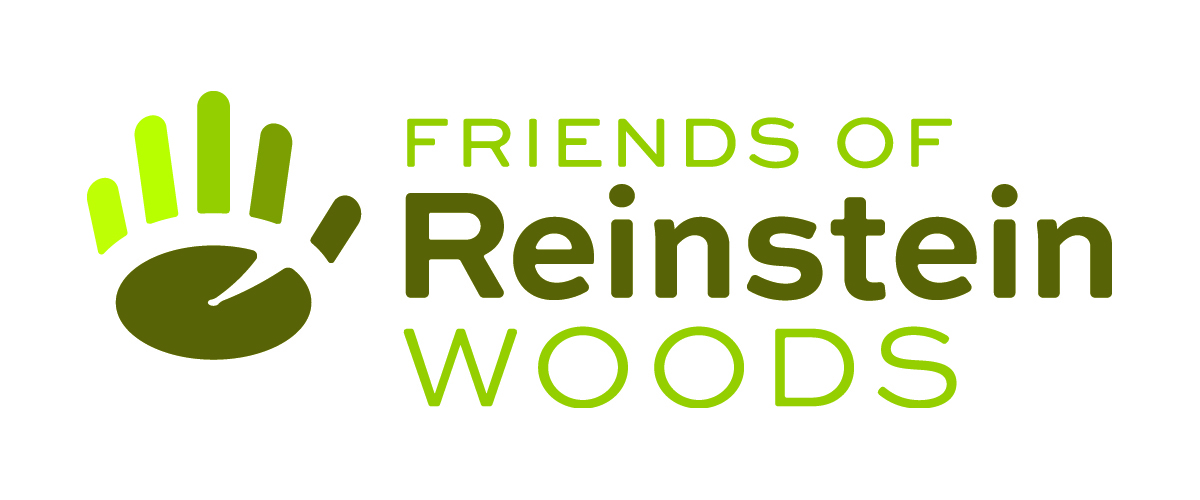Tag Archives: Day in the Life
Reinstein Woods Helps Western New York Students Make Connections Globally
Last year, Reinstein Woods received a federal grant from the National Oceanic and Atmospheric Administration to expand the Day in the Life of the Buffalo River program to include the larger Niagara River/Lake Erie Watershed. The grant allowed us to provide extensive teacher training, classroom learning, and meaningful watershed education experiences for students.

The expanded program uses Global Learning and Observations to Benefit the Environment (GLOBE) protocols, a set of standardized water quality measurement protocols that allow educators and students to connect with others and compare data across the world.
The Holland High School 12th graders have done just that! They collected water quality data and prepared a report comparing the water quality in Western New York to water data collected by peers in Kenya. They plan to present their findings at a science symposium.
Other students got creative in educating others about water quality issues. Students from Stella Niagara, led by teachers Margaret Feuerman and former Reinstein intern Julia Kostin, created public service announcements and “wanted” posters to alert their community to the threat of invasive species in the Niagara River.

And after collecting water quality data from nearby Gill Creek, Niagara Falls High School students created video and print public service announcements warning of the dangers of water pollution.
Student Scientists Brave Rainy Weather to Study Water Quality in the Niagara River/Lake Erie Watershed
“I feel like a real-life scientist!” remarked an excited middle school student from Bennett Park Montessori School as he dove into his first “Day in the Life of the Niagara River/Lake Erie Watershed” experience.

Thanks to a federal grant from the National Oceanic Atmospheric Administration (NOAA), Friends of Reinstein Woods received $66,834 to expand the “Day in the Life” program. “We get to provide students and educators with an unforgettable experience that connects them to their local waterways,” said Day in the Life program coordinator, Mary Ronan. “This grant offers the exciting opportunity to focus on our community taking action towards real environmental change through hands on learning.”
On a very gloomy October 3, more than 330 students and educators from local underserved school districts weathered the rain to collect data from 14 sites along the Niagara River, Buffalo River, and Canadaway Creek.

This was the sixth year of the Day in the Life program, and certainly, the biggest year yet. With the additional funds, Friends of Reinstein Woods was able to purchase updated scientific equipment, greatly expand teacher training, and provide bussing to include eight new schools. One of the new groups was Ms. Hart’s fourth grade class from Hillery Park Elementary, a Buffalo Public School.
The 16 fourth grade students in Ms. Hart’s class were assisted by eighth graders from their school who helped complete the assessments. It was a wonderful opportunity for the eighth graders to serve as mentors for the younger students. Mrs. Hart shared her enthusiasm for the active participation in our environment from all of her students.
“So often, the students are not introduced to science, technology, engineering, and math (STEM) topics until high school, so it’s a great opportunity to show them these,” said Ms. Hart. “Also, their data is used by real scientists!”
The students gained hands-on field experience using the Global Learning and Observations to Benefit the Environment (GLOBE) program protocols to collect data that will be uploaded to a global database. This will greatly enhance research and analysis opportunities. They analyzed water quality, examined what critters live in the waterway, and mapped the area to gain a greater understanding of the watershed. Each site also had a scientist from a partner organization including Buffalo Audubon Society, SUNY Fredonia, Buffalo Niagara Waterkeeper, NYS DEC, Erie County Department of Environment and Planning and more. These representatives enhanced the students’ experience by sharing their knowledge of the river, its issues, and restoration efforts. They also provided an introduction to various environmental career paths.
Throughout the 15-month project, participating educators will engage students in classroom learning using resources gained during a four-day Summer Teacher Institute and subsequent support workshops. This training provides extensive resources and training on the ecological, economical, and recreational importance of the Great Lakes. With a focus on the freshwater resource in our backyard, teachers can partake in place-based meaningful education with students.
Similarly, students completed pre-event activities to learn about their sample site, the greater Niagara River/Lake Erie watershed, and common water quality issues. In the months following the field experience, classes will participate in a stewardship action project such as continued GLOBE monitoring or habitat improvement projects. For example, students at Math, Science and Technology Preparatory School in Buffalo plan to map pervious and impervious surfaces in the schoolyard to better understand stormwater runoff and demonstrate the skills they learned through the Day in the Life program.
The expansion of the Day in the Life program is very exciting for Friends of Reinstein Woods and the Lake Erie Watershed. Through the teacher education workshops, interactive field experience for students, and stewardship action projects, more individuals are prepared to become stewards of the Great Lakes and understand the importance of this vital freshwater resource. “We can only ask students to care about what they are familiar with,” said Ronan. “The grant allows us to make connections between water and everyday life while introducing science skills and career opportunities. We are empowering the next generation of environmental stewards in Western New York.”
Reinstein Woods, Partners Celebrate “A Day in the Life of the Buffalo River”
In October, eight Western New York schools participated in the second annual “A Day in the Life of the Buffalo River” event.
With the help of DEC environmental educators, partners and volunteers, more than 150 students in grades 4-12 collected scientific data along the Buffalo River and its major tributaries, creating a “snapshot” of the watershed at one point in time. Students calculated current speed, measured water and air temperature, observed aquatic life, and investigated water chemistry and weather conditions.
“Providing hands-on experiences for students is something our organization strives to do,” said Friends President Michael Gettings. “This was a great opportunity for area students to connect with this important water resource while practicing skills used by real scientists.”
Many sites had a “river expert” from a partnering organization who shared their knowledge with the students. Partners included the Alliance for the Great Lakes, Buffalo Audubon Society, Buffalo Niagara Riverkeeper, DEC’s Division of Environmental Remediation, DEC’s Great Lakes program, and the U.S. Fish and Wildlife Service.
When asked about their favorite part of the day, one student said, “Being able to actually go in the river and scoop for fish and living things.”
More than half the students came from schools with underserved populations, and schools used this opportunity to enhance what students were already learning in the classroom. Additionally, high school students from Buffalo Public Schools’ International Preparatory School served as mentors to younger students participating at their site at Red Jacket Riverfront Park.
Friends of Reinstein Woods’ educator Brittany Rowan coordinates the program, working to educate teachers about the program ahead of time.
“This program was great! The staff was well trained and knowledgeable,” said Carol Clark, a teacher from St. Mary’s School for the Deaf. This was the first time that St. Mary’s participated in the program.
Data from all sites will be shared on a website built by SUNY Buffalo State College students so classes can compare their data with other participants and previous year’s results.

